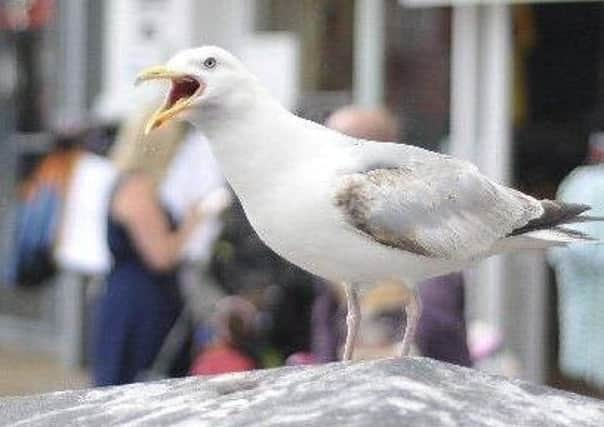VIDEO: Battle with dive-bombing gulls moves inland


Birds are wreaking havoc on innocent members of the public with indiscriminate attacks. Some fearful citizens have even reportedly taken to carrying firearms for protection – from gulls.
For the seagulls’ list of victims seems to grow all the time. Tourists daring to eat ice creams in daylight, fans of fish and chip take-aways, festival goers, school children, cyclists, tortoises, Chihuahuas, supermarket customers, are all seen as fair game from the skies.
Advertisement
Hide AdAdvertisement
Hide AdSo serious is the airborne threat that the Conservative MP for one south-west England constituency called for a parliamentary debate after a friend lost his fish and chips to gulls.
Even the notoriously tough South Africa rugby team was accused of being unnerved as their British coastal training ground was dive-bombed during the 2015 World Cup. National newspapers have featured photos of the birds swallowing rats, pigeons, and in one case reported the violent eating of a starling, as “the poor starling chicks were forced to look on”.
In 2015 the then prime minister, David Cameron, called for a “big conversation” about the challenge and pledged a quarter of a million pounds to fight back, egged on by the then Liberal Democrat MP Don Foster. The gull has Britain rattled, and its enemies appear to crumble. Neither the £250,000 nor Foster survived that year’s general election.
The creatures supposedly terrorising towns and capturing the public imagination are two particular species, the herring gull, Larus argentatus, and its very close cousin the lesser black backed gull, Larus fuscus. Both are large, feisty, greedy generalists happy to pull a worm from a wet lawn or dive bomb a jittery tourist into dropping their lunch.
Advertisement
Hide AdAdvertisement
Hide AdBoth attract critics and supporters in equal measure. The birds are either seen as viscous free loaders who pose a genuine threat to children, or an entertaining part of the British seaside tradition. After all, what exactly do you expect to find beside the sea?
But the gulls’ recent fortunes are complex, with both species widespread in northern Europe. In the 20th century their range of habitat expanded and overall populations rose, perhaps due to a decline in hunting and egg collecting, combined with their adoption of refuse tips as prime foraging sites.
At the same time they have retreated from their traditional coastal breeding haunts and have been making their homes in big cities since the 1940s. But despite appearing to be common, their overall numbers are not on the increase. In the UK in the late 1900s the population of lesser black backed gulls fell by 48% between 2000 and 2013. With most birds breeding in just four super-colonies which have all shown marked declines, the lesser black back is now officially an “amber listed” endangered species.
Inevitably, labelling the birds both as a psychotic murderer and an endangered species causes confusion. Both species are protected by a mix of UK and European law, although nuisance lesser black backs could, until recently, be controlled with a general licence under the UK’s Wildlife and Countryside Act. But this option was withdrawn as the gulls’ numbers fell and did not apply to herring gulls in the first place.
Advertisement
Hide AdAdvertisement
Hide AdSo what do we do about the sometimes ruffled relationship between gulls and humans? Research from a study in the Netherlands indicated that culling of urban populations may be largely ineffective, merely resulting in new birds migrating in to exploit new nesting and feeding opportunities. One response may be to “gull-proof” rubbish and waste bins, reducing the food available and so reducing the major incentive for the birds to share our urban living spaces.
The trouble is, you cannot gull-proof a tourist. The traditional British seaside sights of donkey rides, deck chairs and buckets and spades are now joined by the day tripper holding out a chip to lure in a beady-eyed gull next to a “Do not feed the gulls” sign as other tourists run for shelter. The gulls continue to dive bomb, terrify, and target the unwary.
Meanwhile, the pair of lesser black backs that last year bred on the roof outside my city centre office in northern England are back. As I write this, they are swooping, mewling, and fighting for dominance in the gusts and eddies of campus buildings. Both of their chicks apparently survived and are probably looking forward to their first high season of adolescent rampage at the nearby promenade, where the notorious local gulls have learned to use the automatic doors of fast food outlets.
A version of this article originally appeared on theconversation.com